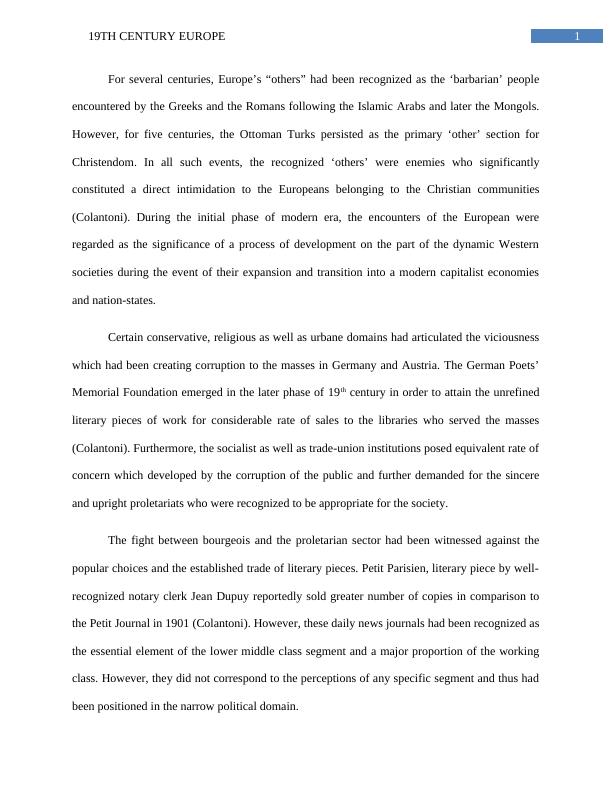19th Century Europe: Encounters, Literary Pieces, and Sport Culture
Added on 2023-06-10
4 Pages662 Words153 Views
Running head: 19TH CENTURY EUROPE
19TH CENTURY EUROPE
Name of the Student:
Name of the University:
Author note:
19TH CENTURY EUROPE
Name of the Student:
Name of the University:
Author note:

119TH CENTURY EUROPE
For several centuries, Europe’s “others” had been recognized as the ‘barbarian’ people
encountered by the Greeks and the Romans following the Islamic Arabs and later the Mongols.
However, for five centuries, the Ottoman Turks persisted as the primary ‘other’ section for
Christendom. In all such events, the recognized ‘others’ were enemies who significantly
constituted a direct intimidation to the Europeans belonging to the Christian communities
(Colantoni). During the initial phase of modern era, the encounters of the European were
regarded as the significance of a process of development on the part of the dynamic Western
societies during the event of their expansion and transition into a modern capitalist economies
and nation-states.
Certain conservative, religious as well as urbane domains had articulated the viciousness
which had been creating corruption to the masses in Germany and Austria. The German Poets’
Memorial Foundation emerged in the later phase of 19th century in order to attain the unrefined
literary pieces of work for considerable rate of sales to the libraries who served the masses
(Colantoni). Furthermore, the socialist as well as trade-union institutions posed equivalent rate of
concern which developed by the corruption of the public and further demanded for the sincere
and upright proletariats who were recognized to be appropriate for the society.
The fight between bourgeois and the proletarian sector had been witnessed against the
popular choices and the established trade of literary pieces. Petit Parisien, literary piece by well-
recognized notary clerk Jean Dupuy reportedly sold greater number of copies in comparison to
the Petit Journal in 1901 (Colantoni). However, these daily news journals had been recognized as
the essential element of the lower middle class segment and a major proportion of the working
class. However, they did not correspond to the perceptions of any specific segment and thus had
been positioned in the narrow political domain.
For several centuries, Europe’s “others” had been recognized as the ‘barbarian’ people
encountered by the Greeks and the Romans following the Islamic Arabs and later the Mongols.
However, for five centuries, the Ottoman Turks persisted as the primary ‘other’ section for
Christendom. In all such events, the recognized ‘others’ were enemies who significantly
constituted a direct intimidation to the Europeans belonging to the Christian communities
(Colantoni). During the initial phase of modern era, the encounters of the European were
regarded as the significance of a process of development on the part of the dynamic Western
societies during the event of their expansion and transition into a modern capitalist economies
and nation-states.
Certain conservative, religious as well as urbane domains had articulated the viciousness
which had been creating corruption to the masses in Germany and Austria. The German Poets’
Memorial Foundation emerged in the later phase of 19th century in order to attain the unrefined
literary pieces of work for considerable rate of sales to the libraries who served the masses
(Colantoni). Furthermore, the socialist as well as trade-union institutions posed equivalent rate of
concern which developed by the corruption of the public and further demanded for the sincere
and upright proletariats who were recognized to be appropriate for the society.
The fight between bourgeois and the proletarian sector had been witnessed against the
popular choices and the established trade of literary pieces. Petit Parisien, literary piece by well-
recognized notary clerk Jean Dupuy reportedly sold greater number of copies in comparison to
the Petit Journal in 1901 (Colantoni). However, these daily news journals had been recognized as
the essential element of the lower middle class segment and a major proportion of the working
class. However, they did not correspond to the perceptions of any specific segment and thus had
been positioned in the narrow political domain.

End of preview
Want to access all the pages? Upload your documents or become a member.